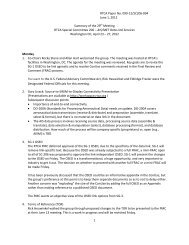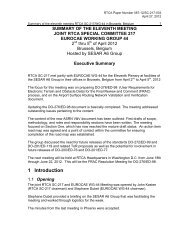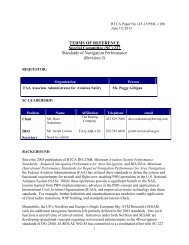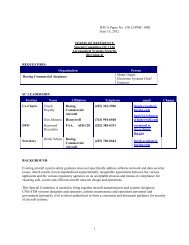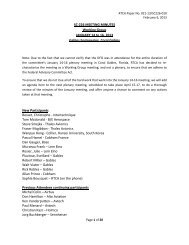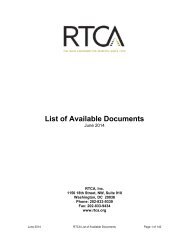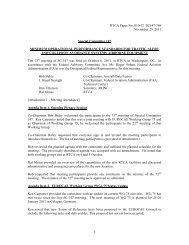Summary of the First Meeting Special Committee 227 ... - RTCA
Summary of the First Meeting Special Committee 227 ... - RTCA
Summary of the First Meeting Special Committee 227 ... - RTCA
Create successful ePaper yourself
Turn your PDF publications into a flip-book with our unique Google optimized e-Paper software.
solve <strong>the</strong> issues. We should consider following through and making sure that someone else will pick up<br />
<strong>the</strong> ball and cover that aspect. We can provide recommendations for how our material is used, but we<br />
cannot make anyone do anything in that respect.<br />
MikeC: to some extent that is what this assumptions section is for.<br />
JohnH: we can expect discussions <strong>of</strong> how RNP 2x is used to achieve separation. We need to also know<br />
who is making <strong>the</strong> decisions on how this capability is used for separation and procedure design, so that<br />
we can participate in those forums.<br />
MikeC: SASP separation panel in particular debated between a Gaussian and double exponential<br />
distribution, and call into question <strong>the</strong> assumptions we make about what 2x RNP really means and how<br />
<strong>the</strong>y can trust it. It is for reasons like this that <strong>the</strong>y are adding buffers.<br />
JohnH: we should consider adding a “lessons learned” section in <strong>the</strong> MASPS as background material to<br />
help people understand what can go wrong and prevent it going forward in applications <strong>of</strong> <strong>the</strong>se<br />
capabilities.<br />
JohnH: RE section 1.5.5, what about non-WGS84 areas what if we fly to countries that to not use<br />
WGS84<br />
Unknown: There is ano<strong>the</strong>r AC that allows for equivalence.<br />
Section 1.5.6.2 – some countries accommodate temperature compensation in procedure design, o<strong>the</strong>rs<br />
assume <strong>the</strong> flight crew will deal with this.<br />
Steve J: <strong>the</strong>re are issues in using temperature compensation in procedure design that can make a<br />
procedure less usable e.g. Hot temperature instead <strong>of</strong> cold temperature.<br />
Frank: 1.5.2 should we add <strong>the</strong> term procedure<br />
1.5.7.1 paragraph on fly-overs needs to be updated.<br />
1.5.7.2 vertical transitions are fly-bys<br />
1.7 definitions<br />
RNP = required navigation performance accuracy<br />
RNP RNAV = meets all requirements <strong>of</strong> this document, including integrity, containment<br />
Frank: need to update figure 1-2 to have an aircraft graphic that doesn’t look like a DC9<br />
The term containment is used different in this document than ICAO. They use it as a 95% containment.<br />
Section 1.7.3 lateral containment<br />
JohnH: regarding P(E2), P(E3), this area assumes <strong>the</strong> airspace infrastructure supports <strong>the</strong> intended RNP<br />
level (e.g. no loss <strong>of</strong> GPS). The assumption is stated elsewhere, but we need it again here to be clear.<br />
Section 2.1<br />
JohnH: Table 2-1 column headings are notoriously misunderstood and have caused problems. They date<br />
back to 1984. We need to fix <strong>the</strong>se misunderstandings.<br />
Section 2.3<br />
Frank: 2.3.2 Continuity requirements for VNAV<br />
Frank: 2.3.4 Continuity requirements for TOAC<br />
Frank: 2.3.5 We should consider addressing wind input requirements here<br />
Section 2.5<br />
16




